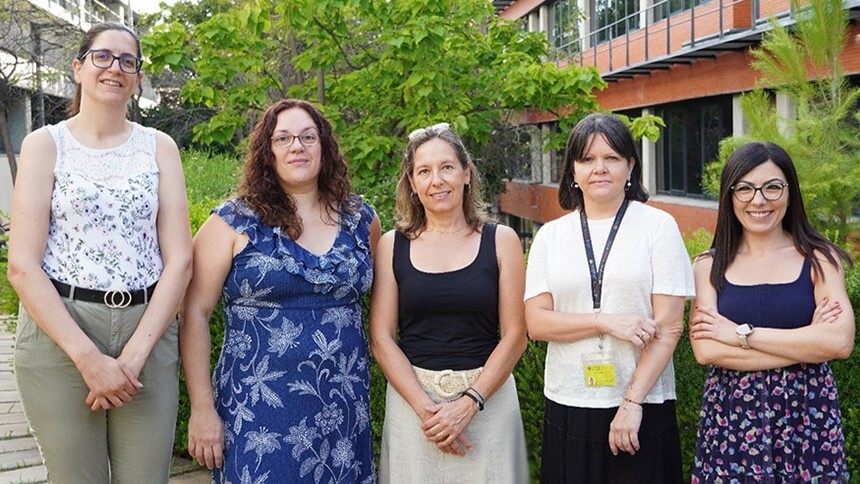Researchers at the Institute of Molecular Science (ICMol), research centre of the University of Valencia Science Park (PCUV) and the Polytechnic University of Valencia (UPV) have developed a system that uses light energy and nanomaterials to activate chemical processes of biomedical interest, especially in the treatment of various types of cancer. For the study, the team used infrared light and nanozymes -nanomaterials with properties similar to natural enzymes- to repair certain lesions similar to those that may occur in human DNA. Results published in Nanoscale
Maintaining the stability of the genome is a top priority for all living organisms. Any change in the original nucleobase sequence may alter key biological processes, impair cell function or initiate a carcinogenic process. Mammalian cells therefore develop their own strategies for repairing damage to their DNA. An example of this is photoreactivation, a natural mechanism that uses visible light to reverse lesions caused by ultraviolet radiation in situ.
In recent years, advances in materials science and catalysis have made it possible to emulate the behaviour of natural enzymes in synthetic systems. This is the case for nanozymes, artificial systems as efficient as natural enzymes. Its environmental and biomedical application, although at different levels of maturity, is being demonstrated.
A team made up of researchers from the Institute of Molecular Science (ICMol), located in the scientific-academic area of the University of Valencia Science Park (PCUV) and the Institute of Chemical Technology (ITQ), of the Polytechnic University of Valencia (UPV) and the CSIC, has described a system for repairing certain DNA lesions using an innovative photo repair strategy.
"The properties of nanomaterials can be used to find solutions to real and complex problems. To this end, basic research must establish simple models that enable technological progress towards the development of innovative medical products based on the use of new nanomaterials", María González Béjar, ICMol researcher and co-author of the article
The work is based on the study of two ethene adducts, lesions caused by oxidative stress and present in the body even without exposure to external carcinogens. For the research, the team has used so-called 'upconversion nanohybrids', nanomaterials that result from the combination of several components and have the ability to emit light in the visible region by absorbing infrared radiation. That is, combine particles activated by infrared light with photosensitizing compounds, successfully repairing the two ethene adducts.
"Photodynamic therapy (PDT) is increasingly gaining prominence as a complementary and selective treatment for various types of cancer, thanks to its ability to destroy tumor cells with minimal involvement in healthy tissues. This approach is becoming a promising alternative to more aggressive conventional treatments", explains Virginie Lhiaubet, researcher at the 'Catalysis Group for Sustainable Organic Reactions' of the Institute of Chemical Technology (ITQ, UPV-CSIC) and co-author of the article in Nanoscale.
"The properties of nanomaterials can be used to find solutions to real and complex problems. To this end, basic research must establish simple models that enable technological progress towards the development of innovative medical products based on the use of new nanomaterials", adds María González Béjar, ICMol researcher and co-author of the article. "From now on, we will work to maximise the efficiency of photo-repair, extend the versatility of light-driven DNA repair strategies and ultimately improve the system we have developed," concludes the scientist.
"From now on we will work to maximize the efficiency of photo repair, expand the versatility of light-driven DNA repair strategies and ultimately improve the system that we have developed," María González Béjar, ICMol researcher and co-author of the article
On the part of the PCUV, the work is carried out in the Photochemical Reactivity Group of the ICMol and is part of the area of Bioapplications, a strategic line included in the recognition of this research center as Maria de Maeztu Excellence Unit, accreditation with which it has been awarded since 2016 and that has just been renewed, for the third consecutive time, by the Ministry of Science, Innovation and Universities.
The study, which is featured in Nanoscale’s Inside Front Cover as recognition of the journal for the quality of the published study, is part of MICIN’s State Knowledge Generation Program (PID2021-128348NB-I00 and PID2023-152131NB-I00) and is also funded, by the EU NextGenerationEU (PRTR-C17.I1), the GVA, ERDF funds and Horizon Europe.
Source: UV News
Recent Posts


